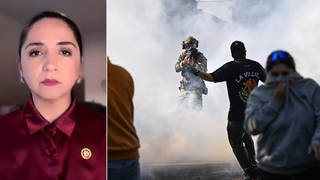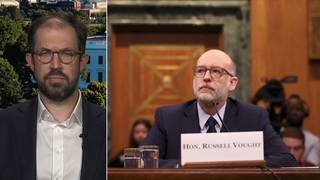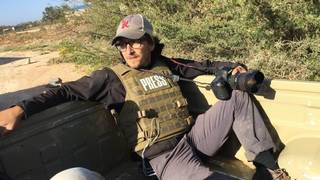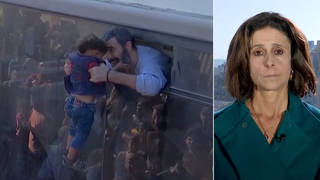
As the push for the Green New Deal builds momentum in the United States, The Intercept has released a short illustrated video imagining a future shaped by the progressive environmental movement. It’s titled “A Message from the Future with Alexandria Ocasio-Cortez.” The New York congressmember narrates the film to envision an America that has been transformed by the Green New Deal policies, including a just transition of jobs, Medicare for all, and a total overhaul of the country’s energy system. The result is a vision of radical hope and transformation. The film features stunning artwork by award-winning illustrator Molly Crabapple. It is presented by The Intercept and Naomi Klein, co-written by Alexandria Ocasio-Cortez and Avi Lewis, and co-directed by Kim Boekbinder and Jim Batt.
Transcript
NERMEEN SHAIKH: The push for the Green New Deal continues to build momentum in the United States. Backers of the bill are launching a nationwide tour tonight to build support for the congressional resolution, which seeks to transform the U.S. economy through funding renewable energy while ending U.S. carbon dioxide emissions by 2030. Two Massachusetts lawmakers, Democratic Senator Ed Markey and Congresswoman Ayanna Pressley, are launching the Green New Deal tour at an event tonight in Boston. Meanwhile, the online news outlet The Intercept has just unveiled a short illustrated video featuring Alexandria Ocasio-Cortez, the New York congressmember who introduced the Green New Deal in the House.
AMY GOODMAN: It’s titled A Message from the Future with Alexandria Ocasio-Cortez. It’s set decades in the future as Ocasio-Cortez looks back at the Green New Deal’s impact on the country. It features stunning artwork by award-winning illustrator Molly Crabapple. We’ll play the video in a moment, but first we turn to Intercept senior correspondent Naomi Klein, who helped make the film. She’s the author of many books, including This Changes Everything: Capitalism vs. the Climate. At an event celebrating the fifth anniversary of The Intercept Tuesday night, Naomi Klein discussed the making of the video.
NAOMI KLEIN: In December, the debate about the Green New Deal was starting to heat up, and it was starting to get ugly. And as you all know, for the past four months, it has been attacked by the serious center and the far right and the absolutely unhinged right, and here and there from the left, with some legitimate critiques.
But for those of us who really want the Green New Deal to succeed, want it to be the best that it possibly can be, see it as our—basically, our last hope for a livable planet, Molly and I were thinking about: How do we kind of do an end run around this misinformation campaign and produce some art and involve artists in the Green New Deal itself? And what Molly and I were talking about is that, first of all, art is low-carbon work. These are green jobs, you know? Green jobs aren’t just guys putting up solar panels. And when we think back to the original New Deal in the 1930s, one of the things that was really amazing about it was that it led to this renaissance of publicly funded art—hundreds of thousands of murals, all of these incredible films and theater pieces, and artists were treated as workers like any other.
The original New Deal was also under relentless attack by the press. There was actually a coup, you know, a sloppy coup, bankers’ coup, to try to overthrow FDR. The reason why it didn’t matter and the popularity still soared was, first of all, it was helping people, but also it had its own communication. And artists were out there, and they were all in for the Green New Deal.
And so, Molly said, “I would love to make a video with AOC.” And we started thinking about what that should communicate and what we should be trying to do. And what we realized was that the biggest problem we are up against, when we think about doing something as transformative as science demands, is the sense of futility that people have, because they’re told all the time that it’s impossible, that they’re just greedy, that they’re just going to spend their whole lives on the couch watching walruses commit suicide on Netflix and just, you know, let the whole thing wash over them. And it’s almost like people think that they don’t deserve to be saved.
And The Intercept had, just a few days earlier, published this really wonderful piece by Kate Aronoff, one of our fantastic reporters and writers, and who’s been a really important theorist for the Green New Deal. And Kate set this piece in the future, in the year 2045. And she told the story of a fictional young woman named Gina who lived in the world that the Green New Deal created. And it really struck a chord with readers of The Intercept. And we realized that it was because it was imagining a future that was actually nonapocalyptic, that did not take the apocalypse for granted, like almost every big-budget Hollywood film that we’ve ever seen, that just imagines the future as like Mad Max, you know, trying to protect your kids from cannibals and warlords, right? And so, that was what inspired this film. And I’m going to stop talking and let the film talk.
REP. ALEXANDRIA OCASIO-CORTEZ: Ah, the bullet train from New York to D.C. It always brings me back to when I first started making this commute. In 2019, I was a freshman in the most diverse Congress in history, up to that point. It was a critical time. I’ll never forget the children in our community. They were so inspired to see this new class of politicians who reflected them, navigating the halls of power. It’s often said, you can’t be what you can’t see. And for the first time, they saw themselves.
I think there was something similar with the Green New Deal. We knew that we needed to save the planet and that we had all the technology to do it, but people were scared. They said it was too big, too fast, not practical. I think that’s because they just couldn’t picture it yet.
Anyways, I’m getting ahead of myself. Let’s start with how we got here. 1977, New York, a senior scientist named James Black made a presentation about how burning fossil fuels could eventually lead to global temperatures rising 4 or 5 degrees Fahrenheit. Within two years, one of the world’s biggest supertankers was outfitted with a state-of-the-art lab to measure CO2 in the ocean, gathering more data about global warming. Guess who was doing all of this research: ExxonMobil, the oil and gas company. Oh, yeah, Exxon knew this whole time, as did our politicians.
Ten years later, James Hansen, NASA’s top climate scientist, told Congress he was 99% certain that global warming was happening and caused by humans. That was 1988, the year before I was even born.
So, did Exxon listen to the science, including their own? Did they change business models, invest in renewables? No, the opposite. They knew, and they doubled down. They and others spent millions setting up a network of lobby groups and think tanks to create doubt and denial about climate change. It was an effort designed to attack and dispute the very kind of science they themselves had been doing.
And it worked. Politicians went to bat for fossil fuels, and these massive corporations kept digging and mining, drilling and fracking, like there was no tomorrow. America became the biggest producer and consumer of oil in the world. Fossil fuel companies made hundreds of billions, while the public paid the lion’s share to clean up their disasters. We lost a generation of time we’ll never get back, entire species we’ll never get back, natural wonders gone forever.
And in 2017, Hurricane Maria destroyed the place where my family was from, Puerto Rico. It was like a climate bomb. It took as many American lives as 9/11.
And in the next year, when I was elected to Congress, the world’s leading climate scientists declared another emergency. They told us that we had 12 years left to cut our emissions in half, or hundreds of millions of people would be more likely to face food and water shortages, poverty and death. Twelve years to change everything—how we got around, how we fed ourselves, how we made our stuff, how we lived and worked—everything.
The only way to do it was to transform our economy, which we already knew was broken, since the vast majority of wealth was going to just a small handful of people, and most folks were falling further and further behind. It was a true turning point. Lots of people gave up. They said we were doomed. But some of us remembered that, as a nation, we had been in peril before: the Great Depression, World War II. We knew from our history how to pull together to overcome impossible odds. And at the very least, we owed it to our children to try.
The wave began when Democrats took back the House in 2018, and then the Senate and the White House in 2020, and launched the decade of the Green New Deal, a flurry of legislation that kicked off our social and ecological transformation to save the planet. It was the kind of swing-for-the-fence ambition we needed. Finally, we were entertaining solutions on the scale of the crises we faced, without leaving anyone behind. That included Medicare for all, the most popular social program in American history. We also introduced the federal jobs guarantee, a public option including dignified living wages for work. Funnily enough, the biggest problem in those early years was a labor shortage. We were building a national smart grid, retrofitting every building in America, putting trains like this one all across the country. We needed more workers.
That group of kids from my neighborhood were right in the middle of it all, especially this one girl, Ileana. Her first job out of college was with AmeriCorps Climate, restoring wetlands and bayous in coastal Louisiana. Most of her friends were in her union, including some oil workers in transition. They took apart old pipelines and got to work planting mangroves with the same salary and benefits. Of course, when it came to healing the land, we had huge gaps in our knowledge. Luckily, indigenous communities offered generational expertise to help guide the way. Ileana got restless, tried her hand as a solar plant engineer for a while but eventually made her career in raising the next generation as part of the universal child care initiative. As it turns out, caring for others is valuable, low-carbon work. And we started paying real money to folks like teachers, domestic workers and home health aides.
Those were years of massive change. And not all of it was good. When Hurricane Sheldon hit southern Florida, parts of Miami went underwater for the last time. But as we battled the floods, fires and droughts, we knew how lucky we were to have started acting when we did. And we didn’t just change the infrastructure. We changed how we did things. We became a society that was not only modern and wealthy, but dignified and humane, too. By committing to universal rights like healthcare and meaningful work for all, we stopped being so scared of the future. We stopped being scared of each other. And we found our shared purpose.
Ileana heard the call, too. And in 2028, she ran for office, in the first cycle of publicly funded election campaigns. And now she occupies the seat that I once held. I couldn’t be more proud of her, a true child of the Green New Deal.
When I think back to my first term in Congress, riding that old-school Amtrak in 2018, all of this was still ahead of us, and the first big step was just closing our eyes and imagining it. We can be whatever we have the courage to see.
AMY GOODMAN: That’s the film, A Message from the Future with Alexandria Ocasio-Cortez, presented by The Intercept and Naomi Klein and illustrated by award-winning artist Molly Crabapple. The film was co-written by Alexandria Ocasio-Cortez and Avi Lewis, and co-directed by Kim Boekbinder and Jim Batt. After break, we’ll be back with Molly Crabapple and Avi Lewis.











Media Options